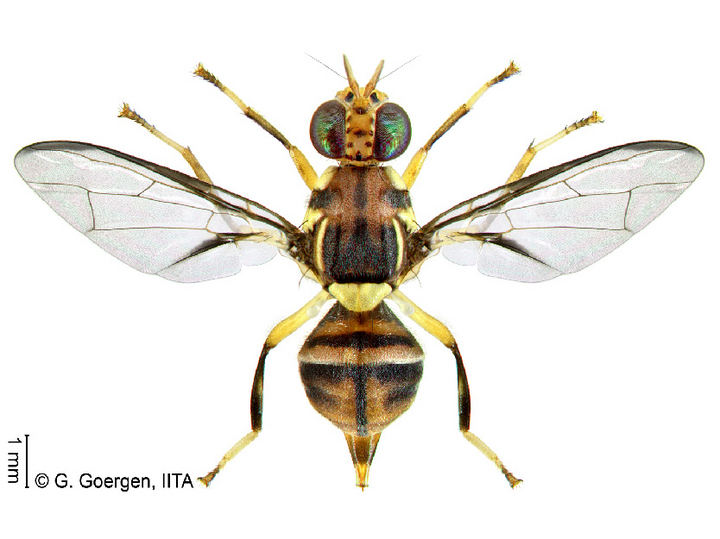Oriental fruit fly
Bactrocera dorsalis
Appearance

Die Abbildung der Adulten Orientalischen Fruchtfliege "Bactrocera dorsalis" von G. Goergen IITA ist lizenziert unter CC BY 4.0
The Oriental fruit fly belongs to the fruit fly family (Tephritidae). The species is known by a number of synonyms, including Bactrocera invadens, B. papayae, and B. philippinensis. It is the central species in the species complex of the same name(Bactrocera dorsalis complex), which includes a large number of species, some of which are barely distinguishable.
The adult flies are about 5 mm in size and are predominantly black or dark colored, but also have yellow colored areas, such as a yellow dorsal shield. The wings have a continuous dark stripe along the anterior edge of the wing.
The larvae (maggots) are white to cream colored, up to 1 cm long in the last larval stage, and have a black mouth hook.
Biology
The females of the oriental fruit fly lay eggs under the skin of ripening fruit. The larvae hatch from these eggs, where they feed and develop. They then leave the fruit and drop to the ground. Pupation takes place in the soil under the host plant and the adults hatch from the pupae. The entire development cycle is temperature-dependent and lasts only a few weeks under optimal conditions (23 °C - 32 °C). The adults can live for several months and the females lay several hundred eggs during this time.
Damage symptoms
Infested fruits have puncture marks from egg laying. The feeding larvae are found in the fruit and destroy the flesh. As a result, this can also lead to rotting of the fruit. This can cause significant damage to the interior of the fruit even before symptoms are readily visible externally. In early stages of infestation, any symptoms of damage are difficult to detect. Since this fruit fly species only attacks fruit, there is no damage to other parts of the plant, such as leaves, trunk, branches or roots.
Host plants
The Oriental fruit fly is a highly polyphagous fruit fly (i.e., it can feed on many different plants) and has the broadest host plant range of any Bactrocera species, with over 300 different plant species on whose fruits development is possible.
Major host plants include mangoes(Magnifera indica), oranges(Citrus sinensi), and other citrus fruits. However, a variety of wild and cultivated plants would also potentially be available in Europe such as peach(Prunus persica), apricot(P. armeniaca), plum(P. domestica), apple (Malus domestica), pear(Pyrus spp.) as well as tomato (Solanum lycopersicum), bell pepper(Capsicum spp.) and other fruit-bearing plant species.
Distribution
The Oriental fruit fly is native to tropical Asia and Oceania and has been recorded in sub-Saharan Africa. The presence on the African continent is likely to be due to introductions during the past two decades. Individual introductions are also known for other regions and continents, e.g. the United Arab Emirates. In Austria, individual specimens of the Oriental fruit fly have been found in recent years. However, these are not established populations. Establishment of this tropical fruit fly species can currently be ruled out due to winter weather conditions in Austria. Also from other countries of the European Union no established population is known so far.
Propagation and transmission
The spread of the oriental fruit fly can be active or passive. The most important way of spreading is by means of infested fruits (merchandise, luggage of travelers) to previously uninfested areas. In addition, the oriental fruit fly can be spread passively by wind dispersal over long distances. Active dispersal occurs through the flight of adults.
Prevention and control
- Detection of the occurrence (monitoring): Attachment of suitable fruit fly traps (e.g. Delta traps, McPhail traps, ...) to catch adults using specific attractants:
- Parapheromone (methyl eugenol) to attract males
- protein-based, to attract female flies
- There are currently no plant protection products authorised against this pest in Austria (see list of plant protection products authorised in Austria)
Phytosanitary status
Non-European fruit flies (Tephritidae) such as Bactrocera dorsalis are listed as Union quarantine pests of the European Union and are thus subject to legal regulations to prevent their introduction and spread into or within the member states of the EU. Please observe the obligation to notify in case of an occurrence and contact theofficial plant protection service of your federal state.
Specialist information
Research
Since 2012, we and the official plant protection services of the federal states have been continuously monitoring the occurrence of these and other important fruit fly species in Austria.
We are also involved in various European and international co-operations and projects on fruit flies:
EUPHRESCO network project FLY DETECT
H2020 project: FF-IPM - Fruit Flies In-silico / Prevention & Management
Publications
Milonas, P., Egartner, A., Ivanova, I., 2020. Development and implementation of early detection tools and effective management strategies for invasive non-European and other selected fruit fly species of economic importance (FLY DETECT). Zenodo. http://doi.org/10.5281/zenodo.3732297
Egartner, A., Lethmayer, C., Gottsberger, R. A., Blümel, S., 2019. Survey on Bactrocera spp. (Tephritidae, Diptera) in Austria. Bulletin OEPP/EPPO Bulletin 49(3). https://doi.org/10.1111/epp.12604
Lethmayer, C., Egartner, A., 2019. Invasive flies in domestic fruit production. Better Fruit 8, 7-8.
Last updated: 28.10.2024
automatically translated